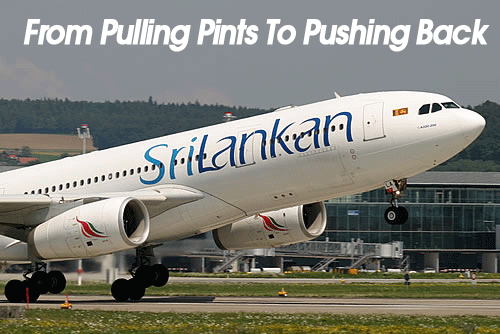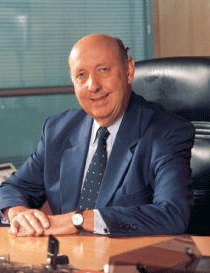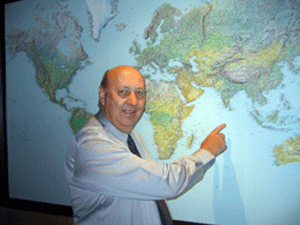
 If
Peter Hill, Chief Executive Officer of SriLankan Airlines ever gets tired
of the transport game (doubtful with everything else going on in Sri Lanka,
he could ever get bored) the career aviation man who among other things
was part of the team present during the creation of Emirates Airline,
might consider opening up a London style pub in Colombo. If
Peter Hill, Chief Executive Officer of SriLankan Airlines ever gets tired
of the transport game (doubtful with everything else going on in Sri Lanka,
he could ever get bored) the career aviation man who among other things
was part of the team present during the creation of Emirates Airline,
might consider opening up a London style pub in Colombo.
He did about the same thing the last time
he departed an airline assignment, about a decade ago, traveling back
to London and setting up shop as owner operator of a grand and historic
pub called The Constitution on Regents Canal.
In 1996, after 18 years in Dubai, Hill returned
to London and bought the pub.
“The Constitution is a great place.
“I purchased it with a partner (who
still operates the pub having bought out Mr. Hill’s shares) and
actually lived upstairs above the business for two years.”
But when Emirates acquired 40% of Sri Lankan
(EK now holds 43%) and signed a decade-long management contract to operate
the carrier, a call from EK HQ came into London.
The lifetime airline guy knew his days of
pulling pints were numbered.
“It was a great experience, but in
the end I got a bit bored with the pub.
“Looking back, that time was fun and
a needed change after years of always being on the road and living out
of a suitcase much of the time.”
We are sitting in the executive offices
atop the Colombo Sri Lanka World Trade Center.
Outside and way down below, the hustle of
the city pulses along, but here it is quiet in tones of rich wood and
high back chairs.
I tell Peter Hill that like my U.S. President
whose Secret Service detail always has one—he too has a “body
double” lurking about.
He says right away “Oh yes . . Barry,”
(Barry Brown, Chief Commercial Officer) and after a moment it comes to
him and he laughs out loud.
I decide I like this guy right away, but
am not sure if it is his pub manners, which in any case are just great.
Right now in his eighth year as CEO at SriLankan,
Peter Hill has literally lifted that carrier up from the ashes having
survived all manner of challenge, including a terrorist attack in 2001
that destroyed half of the fleet.
He recalls being awakened at 4:20 a.m. one
July night in 2001 and for a moment not believing what he was hearing.
“It was like being suspended between
sleep and being awake; as in a strange yet very real dreamlike state.
“One of my duty managers called screaming
that the airport was under attack.
“Rebels have occupied the airport
and they’re blowing up our aircraft,” he said.
“Through the phone line I could hear
the explosions and gun fire.”
A Tamil Tiger suicide squad had gained access
to the hardstand and went about blowing up three SriLankan Airlines Airbuses
while badly damaging three others.
In an instant Peter Hill learned that half
the fleet had gone up in flames.
But from that devastation something unexpected
happened.
In an atmosphere of declining business and
continued losses for the airline had come this horrific attack followed
by an insurance settlement of about USD$350 million.
As he sat looking at the check on his desk
inside the airline’s office in Colombo’s World Trade Center,
a new beginning was formed.
Here was this airline in the immediate aftermath
of terror attacks with its main revenue base of tourists badly eroded.
“What the hell do we do next?”
Peter Hill thought.
Turns out the check offered some flexibility
toward a new beginning that in a strange twist of fate might not have
been available.
Peter Hill, it turns out given the chance,
had a better idea.
While continuing to discover new and better
ways to build the airline as an engine to draw world tourism to beautiful
Sri Lanka, he would also take advantage of the island nation’s unique
position in relation to India and the global trade lanes.
 “Our
vision is to create Sri Lanka as the hub in South Asia,” he said. “Our
vision is to create Sri Lanka as the hub in South Asia,” he said.
Non cost-effective schedules were withdrawn
and new routes that offered prospects of growth and profitability were,
and still are, being initiated.
Thus began the transformation of SriLankan
Airlines from a destination carrier into a network operator.
Has the strategy worked?
Given the high costs of fuel and security
that continue to exert immense downward pressure on yields almost everywhere,
SriLankan Airlines right now, as indication, is the biggest foreign carrier
operating in India with nine destinations and a tenth to be added in the
Winter schedule.
“We are developing business traffic,
to maximize short-haul tourist travel from the Indian subcontinent to
Sri Lanka.
Relative to India, the cost of holidays
in Sri Lanka are considerably less expensive, and with most flights from
India taking no more than 90 minutes to reach Sri Lanka, the opportunities
presented are enormous.
Things continued to build with expanded
cooperations with codeshare operator Emirates and markets, that while
not booming were at least on a solid growth curve.
Then came the Tsunami of December 2004.
Although the Tsunami affected only one small
part of the island (Kalutara Beach was especially hard hit) and Sri Lanka
is in fact a multi-destination country with beaches, the hill country,
the tea country, the wildlife parks, and many World heritage sites, the
region’s travel industry took a tremendous hit.
Peter Hill radically revamped SriLankan’s
schedule, “answering the call to fly daily services to most of the
destinations we serve.”
“The Tsunami was devastating for tourism
in the Asian region so as part of the Bounce Back Sri Lanka Program we
added many new services whilst concentrating on our core markets.”
Today with growing schedules, SriLankan
now features a daily return service from Colombo to New York’s JFK
Airport begun on March 27th of 2005 that opened up a whole new market
for the airline, the country and neighboring South Asian communities.
“Partnering with Emirates via codeshare
services, the flights are also producing excellent results for our growing
air cargo product.”
Also in the mix is a growing list of European
destinations including Frankfurt, Munich and Düsseldorf as well as
Paris and Zurich operated by both SriLankan Airlines and codeshare partner
Emirates.
“Last summer we launched A330 daily
service to Abu Dhabi with services continuing to Doha and Bahrain.”
Saudi Arabia and Kuwait also saw services
added. Also in mix are frequencies to South East Asia and China.
The SriLankan and Emirates codeshare flights
to Dubai now total 28 services per week from Colombo.
Pivotal to SriLankan’s growing success
is its belief that the government should try to attract ‘quality’
carriers back to Sri Lanka.
Despite some past and current social unrest,
by most estimates, the peace process will continue and Sri Lanka is being
‘re-discovered’ by higher spending tourists, which in turn
is improving yields.
As this is written, Mr. Hill may have gotten
something of his wish for more airlines as the Sri Lankan Civil Aviation
Authority (CAA) just announced granting permission for three new carriers
to join international aviation in July.
Three new airlines Expo Aviation, Holiday
Airlines and Deccan Aviation have been granted permission by CAA to initially
serve destinations in India.
Born in Somerset and brought up in London,
Peter Hill joined British Airways as a commercial trainee at 17.
He did a stint in Uganda before joining
Gulf Air in Bahrain.
After moving to Dubai, Mr. Hill joined Emirates
Airlines with responsible for all of Emirates’ commercial operations
east of Dubai, including Australia, Hong Kong, India and Sri Lanka.
Looking ahead Mr. Hill notes that right
now having faced down crises after crises he has firmly put his roots
in paradise while taking a bride just last year.
“Whatever the future holds, my life
will be centered in Sri Lanka.
“We are just working with a newly
elected regime here as our management contract comes up for renewal in
two years.”
Yet to be decided are important decisions
as to how SriLankan will continue upon its courageous and bold path into
the future.
“Our plan calls for new equipment,
more destinations and marketing initiatives plus the need to develop even
further the culture for commercial aviation in Sri Lanka by emphasizing
training and education here.
“Despite operating in a difficult
economic and very competitive climate, SriLankan has proved, without doubt,
that a strongly managed airline with innovative and visionary ideas can
succeed whatever the odds.”
(Geoffrey Arend)
|



